Science / The most important results
2015
Ceramic armour-protecting material.
Authors: G.R. Karagedov, A.L. Myz, N.Z. Lyakhov
Ceramic armour-protecting material was manufactured using the method of obtaining nanometer-sized (80-120 nm) α-Al2O3 powder developed at the ISSC SB RAS, and patented. The hardness and crack-growth resistance of the new material are higher than the corresponding characteristics of the domestic analogs and the material based on Almatis-1200 powder. The technology is at the stage of scaling and may be promising for manufacturing armour-protecting materials.
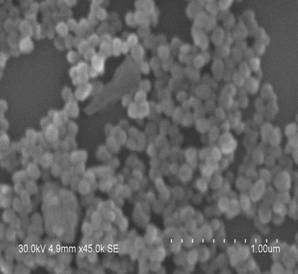 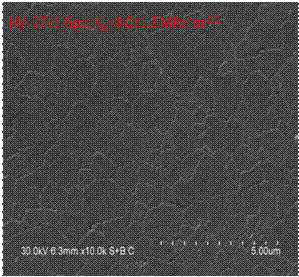
|
|
|
Electron microscopic images of α-Al2O3 nanopowder (left) and the microstructure of ceramic material prepared on the basis of the powder.
|
Publications:
A.L. Myz, G.R. Karagedov, N.Z. Lyzkhov. Bulletin of the Siberian Branch of the Academy of Military Sciences. 2015. No. 34. P. 86-89.
Composites in the system Fe-Ga for obtaining elastic magnetostrictive materials.
Authors: T.F. Grigorieva, N.Z. Lyakhov
Nanocomposite Fe3Ga/Fe(Ga)/Fe was synthesized with the help of mechanical activation at the ISSCM SB RAS in collaboration with the Moscow State University and the United Institute of Mechanical Engineering of the National Academy of Sciences of Belarus. Compaction of the nanocomposite with the help of thermobaric agglomeration allowed conserving the nano-sized and phase state of the material. The mechanocomposite was used to obtain elastic magnetostrictive materials. It was shown that the maximal functional characteristics are achieved with 15% mechanocomposite in polyurethane (PU). The obtained material exhibits the characteristics not worse than those of existing magnetostrictive materials but is elastic and substantially cheaper than the existing materials. Due to huge magnetostrictive effects, the alloys Fe1-xGax (x<0.3) may be used in magnetoelectric sensors of magnetic field converters, vibrogenerators.
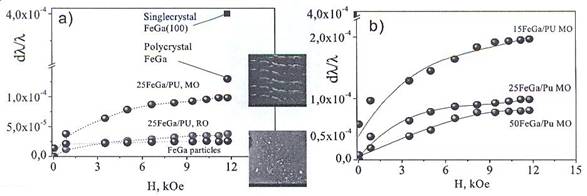
|
|
Magnetostrictive characteristics of composite materials Fe3Ga/Fe(Ga)/Fe / PU in the external magnetic field.
|
Publications:
- T. Grigorieva, S. Kiseleva, V. Senyut, P. Vityaz, N. Lyakhov. Thermobaric sintering of mechanocomposites of the system Fe-Ga. J. Mater. Sci. Engineering. 2015. Vol. B5. No. 7-8. P. 1-7.
- T.Yu. Kiseleva, S.I. Zholudev, A.A. Novakova, T.S. Gendler, I.A. Il’inykh, A.I. Smarzhevskaya, Yu. Anufriev, T.F. Grigorieva. Magnetodeformational anisotropy of FeGa/PU hybrid nanocomposite via particle concentration and spatial orientation. Solid State Phenomena. 2015. Vols. 233-234. P. 607-610.
Model describing photomechanical effects in crystals.
Authors: S.A. Chizhik, E.V. Boldyreva
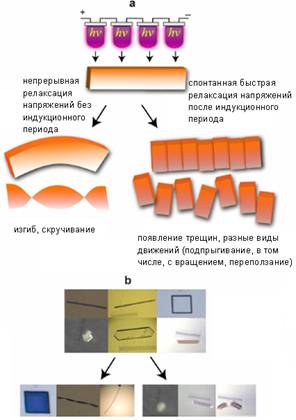
Mathematical model developed at the ISSCM SB RAS allows the quantitative description and prediction of the variety of photomechanical effects in crystals (bend, twisting, saltatory or continuous movement, fragile or plastic destruction etc.). The scientists of the Institute were among the first who discovered this phenomenon in 1089-es and started to investigate it. In the beginning of the 21th century this direction has suddenly become one of the most popular ones in chemical studies, in connection with the development of supramolecular devices and materials, and the studies of the mechanisms of physicochemical processes and mechanical phenomena in living organisms. With the help of this model, the entire massif of experimental data published by present and accounting for more than a thousand papers has been analyzed. The results of the work were published in Chemical Reviews:
P. Naumov, S. Chizhik, M.K. Panda, N.K. Nath, E. Boldyreva. Mechanically responsive molecular crystals (Review). Chem. Rev. 2015. Vol. 115 (22). P. 12440-12490. DOI: 10.1021/acs.chemrev.5b00398.
The reviewers of the work characterized it as an instant classic that will define the development of this area of science for the forthcoming decades.
Development of radiation-thermal method of obtaining motor oil additives.
Authors: M.A. Mikhailenko, B.P. Tolochko
Additives for all kinds of motor oil were manufactured at the ISSCM SB RAS together with INP SB RAS using the radiation-thermal method. Radiation-stimulated polymerization of the monomers of metacryl series (MMA) used to manufacture the additives was carried out in the environment of heavy hydrocarbons using intense electron beams. Irradiation conditions causing no destruction of the heavy hydrocarbon basis and allowing us to obtain stable viscous compositions were determined. The work was carried out at the industrial accelerator ILU-6, which allowed us to implement synthesis conditions close to the industrial ones. The simplicity and flexibility of the method allow us to vary the characteristics of the additives and to obtain motor oil with special properties, in particular for use under the conditions of the Arctic regions of the Russian Federation. The work was supported by the technological platform Nuclear Technologies of the Skolkovo innovative center.
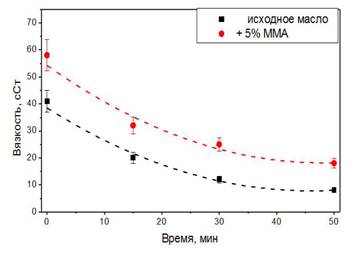
|
|
Determination of the stability of motor oil according to the State Standard GOST-5789-78: initial oil (lower curve) and the composition of initial oil with methylmetacrylate treated with the ionizing radiation (upper curve). The action for 50 minutes is equivalent to motor work for the kilometrage of 100 thousand km.
|
Supramolecular complexes of medical preparations with arabinogalactan as innovative medicinal agents of increased safety and efficiency.
Authors: A.V. Dushkin, N.Z. Lyakhov
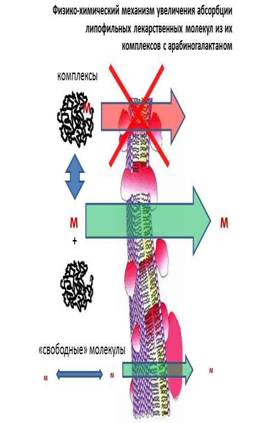
At the ISSCM SB RAS in collaboration with the NIOCh SB RAS, it was demonstrated for the examples of medical substances of antiaggregants, tranquilizers, anti-inflammatory, antimicrobial, antihypertensive, and antihelminthic (in particular against opistorchosis) agents that the inclusion of pharmaceutical molecules (PM) into intermolecular complexes with water-soluble polysaccharide arabinogalactan (AG) extracted from larch wood of Larix sibirica and Larix gmelinii allows a multiple enhancement of the pharmacological activity of PM for oral intake or a decrease in the dose with the conservation of the basic action. The indicated complexes are synthesized using the solid-phase mechanochemical route and possess enhances water solubility. The physico-biological mechanism of the improvement of pharmacological characteristics of these supramolecular structures was revealed: the macromolecules of AG after oral intake are not absorbed into the bloodstream, and an increase in absorption is due to the creation of an increased concentration of the PM in the gastrointestinal tract both in the free state and in the complex with AG. The obtained results verify the approach to obtaining supramolecular complexes of pharmaceutical molecules as a route to manufacture innovative medicines of increased safety and efficiency to replace expensive imported preparations.
Publications:A.V. Dushkin, Y.S. Chistyachenko, D.A. Komarov, M.V. Khvostov, T.G. Tolstikova, I.F. Zhurko, I.A. Kirilyuk, I.A. Grigor’ev, N.Z. Lyakhov. About the mechanism of membrane permeability enhancement by substances in their intermolecular complexes with polysaccharide arabinogalactan from larches Larix sibirica and Larix gmelinii. Doklady Biochemistry and Biophysics. 2015. Vol. 460, Iss. 1. P. 9-12.





